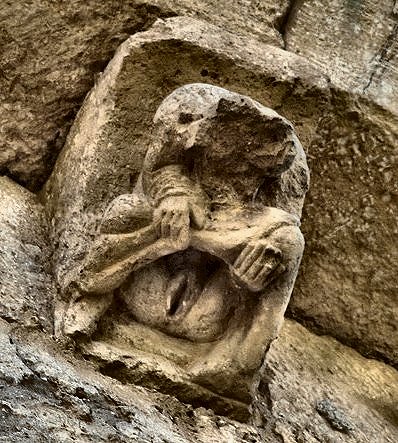|
Lammas (Norfolk)
Found amongst rubble of a wall of a seventeenth-century house, this broken sandstone figure (just under 30 cms high) is now in the care of Norfolk Museums service (Bridewell Museum), and is unique in being clothed. She is raising her skirt to reveal a slit-vulva around which the
pubic hair is, unusually, depicted.
This small carving could well have been modelled on a large and famous marble from one of the town gates of Milan (below), where a handsomely Roman-looking matron raises her dress in determinedly apotropaic manner to keep evil and danger out of the town - or to comb her pubic hair - unless it is a knife - or a douche - she holds in her right hand ? (Some have thought it to be a phallus!) The Porta Tosa sculpture (now in the Castle Museum) in turn recalls the exhibitionist figurines of the minor Greek/Egyptian deity Baubô, who assisted Persephone by doing the same thing and snapping her out of her Plutonic depression. If she is shaving her pubic hair, it could perhaps be to increase the apotropaic effect. But it seems to me more likely that she is a hermaphrodite who has just cut off his entire genitalia. The instrument involved looks more like a knife than a comb. Gates, of course, are liminal structures, and often feature figures of one kind or another. Exhibitionist figures have been reported also on mediæval town gates in Barcelona and Antwerp. However, in a short paper entitled 'An Exhibitionist Carving from
Lammas, Norfolk', in Bulletin No. 27 of the CBA Group VI, J.A. Jerman
suggested that the Lammas plaque was originally male and was subsequently
and drastically altered:
for a remarkable Italian
|
Fuentidueña (Segóvia)



Stockholm.jpg)


